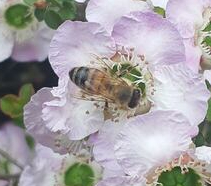
Apis Melliferais the most common species of honey bee worldwide. As the name suggests, they are originally native to Europe, but they are now found on every continent, excluding Antarctica, as they were introduced to these places by settlers from the 1600s onwards
They live in colonies, controlled by a fertile queen, who is supported by worker drones. They use pheromones and dance to communicate.
They are threatened by Verroa mites and colony collapse disorder, which have caused the near extinction of wild Apis Mellifera in Europe
Unlike most bee species, their colonies remain in the same location year after year, and reproduce through swarming. When they swarm they use the spring abundance of pollen and nectar to create 12 to 24 new queens. Just before the new queens are adults, two thirds of the colony leaves with the old queen to create a new hive. The now adult queens fight to the death, and the winner rebuilds the original colony